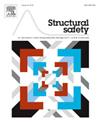System risk modelling and decision-making – Reflections and common pitfalls
IF 5.7
1区 工程技术
Q1 ENGINEERING, CIVIL
引用次数: 0
Abstract
Since its foundation, the Joint Committee on Structural Safety (JCSS) has been engaged in the discussion of methods for determining the reliability of components, calibration of standards, as well as risk modelling of systems. In publications, it is regularly explained which methods have which advantages. In the literature, the drawbacks and pitfalls that challenge rational decisions and help to develop and find more appropriate methods for practice are often not documented.
Such problems can lead to decisions, which are not rational from a decision-theoretic point of view, some of which are worse than a random decision. Especially events, with a very small probability of occurrence hardly give any feedback possibilities from reality and evidence-based analysis of decisions is not possible. Careful selection of methods and knowledge/information of the assumptions is crucial to rational decisions.
This paper will discuss some of the identified pitfalls based on the discussions in the JCSS. It will span from aspects in the uncertainty quantification, uncertainty propagation, consequence assessment as well as approaches that are found and used in practice for decision-making (e.g. probability interpretations, risk aversion, risk matrices and FN diagrams). This paper can be seen as a documentation of outtakes from the discussions which led to the joint understanding and approach of the JCSS. The paper does not claim to be complete concerning all the possible pitfalls in risk assessments and system identification. But it does provide important reflections and indicates where the eyes must be kept open. Further, the paper points to a way of rational decision-making accounting for the uncertainties in information.
系统风险建模与决策--思考与常见误区
自成立以来,结构安全联合委员会(JCSS)一直致力于讨论确定组件可靠性的方法、标准的校准以及系统的风险建模。在出版物中,通常会解释哪种方法具有哪些优点。在文献中,挑战理性决策并帮助开发和找到更适合实践的方法的缺陷和陷阱通常没有被记录。这些问题可能导致决策,从决策理论的角度来看,这些决策是不合理的,其中一些比随机决策更糟糕。特别是事件,发生的概率非常小,很难提供任何来自现实的反馈可能性,也无法对决策进行基于证据的分析。仔细选择方法和假设的知识/信息对理性决策至关重要。本文将根据JCSS中的讨论讨论一些已确定的陷阱。它将涵盖不确定性量化、不确定性传播、后果评估以及在决策实践中发现和使用的方法(例如概率解释、风险规避、风险矩阵和FN图)等方面。这篇论文可以被看作是一份关于讨论成果的文件,这些讨论导致了对JCSS的共同理解和方法。本文并未对风险评估和系统识别中所有可能存在的缺陷提出完整的建议。但它确实提供了重要的反射,并指出眼睛必须睁开的地方。在此基础上,提出了一种考虑信息不确定性的理性决策方法。
本文章由计算机程序翻译,如有差异,请以英文原文为准。
求助全文
约1分钟内获得全文
求助全文
来源期刊

Structural Safety
工程技术-工程:土木
CiteScore
11.30
自引率
8.60%
发文量
67
审稿时长
53 days
期刊介绍:
Structural Safety is an international journal devoted to integrated risk assessment for a wide range of constructed facilities such as buildings, bridges, earth structures, offshore facilities, dams, lifelines and nuclear structural systems. Its purpose is to foster communication about risk and reliability among technical disciplines involved in design and construction, and to enhance the use of risk management in the constructed environment
 求助内容:
求助内容: 应助结果提醒方式:
应助结果提醒方式:


